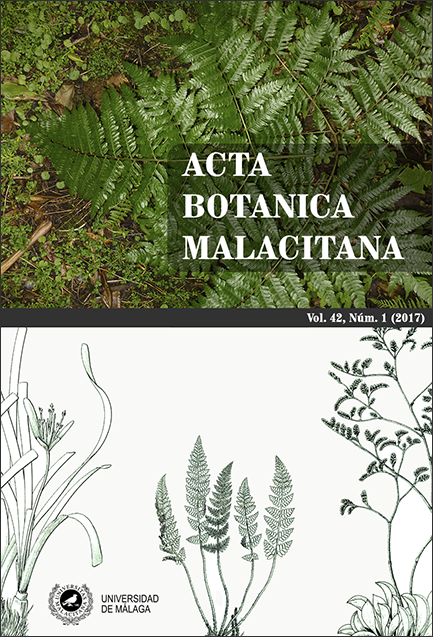Novelties in Lindsaea (Lindsaeaceae) from South America.
DOI:
https://doi.org/10.24310/abm.v42i1.3007Abstract
En este artículo se describen e ilustran tres especies nuevas de Lindsaea
Dryand. ex Sm. para Suramérica: L. falcatosora A. Rojas, L. nana A. Rojas y
L. trapezoidalis A. Rojas. La primera especie difiere de L. pleioptera Kramer por sus pinnas falcadas (en frondas 1-pinnadas) o pínnulas (en frondas 2-pinnadas), con soro falcado restringido a 2/3 basales, o ausente en 1/3 apical donde la lámina es dentada. La segunda especie difiere de L. falcata Dryand. por frondas más pequeñas (4.5–8 × 1.7–2.6 cm vs. 10–25 × 4–7.5 cm), pinnas perpendiculares a ligeramente ascendentes (vs. falcadas) y segmento apical subconforme (vs. conforme), deltado (vs. hastado). La tercera especie difiere de L. taeniata Kramer por sus estípites and raquises angulados (vs. teretes) y pínnulas proporcionalmente más cortas (2-3.5 veces más largas que anchas vs. al menos 5 veces más largas que anchas). También tres variedas son combinadas como especies.
Downloads
Metrics
References
Boudrie, M. & Cremers, G. (2005). Une nouvelle variété de Lindsaea lancea (Pteridophyta, Dennstaedtiaceae) du plateau des Guyanes Adansonia, sér. 3, 27 (1): 9-16.
Gómez, L.D. & Arbeláez, A.L. (2009). Flora de Nicaragua. Tomo IV: helechos. St. Louis, Missouri, USA: Missouri Botanical Garden.
Kramer, K.U. (1957).Arevision of the genus Lindsaea in the new world with notes on allied genera. Acta Bot. Neerl. 6: 97–290. https://doi.org/10.1111/j.1438-8677.1957. tb00576.x
Kramer, K.U. (1989). Lindsaea mesarum, a new fern species from the Roraima Sandstone. Ann. Missouri Bot. Gard. 76: 605–607. 1989.
Lehtonen, S., Tuomisto, H. Rouhan, G. & Christenhusz, M.J.M. (2010). Phylogenetics and classification of the pantropical fern family Lindsaeaceae. Bot. J. Linn. Soc. 163: 305–359. https://doi.org/10.1111/j.1095- 8339.2010.01063.x
Mickel, J.T. & Smith, A.R. (2004). The Pteridophytes of Mexico. Mem. New York Bot. Gard. 88: 1–1029.
Moran, R.C. (1995). Lindsaea. In: R.C. Moran & R. Riba, (eds.). Flora Mesoamericana. Vol.1. Psilotaceae a Salviniaceae. México, DF: Universidad Nacional Autónoma de México. p. 157–160.
Moran, R.C. (2011). Géneros neotropicales de helechos y licófitas. San José, Costa Rica: Organización para Estudios Tropicales. Mimeografiado. 407 p.
Murillo, M.T., Murillo, J., León, A. & Triana, L.A. (2008). Los Pteridófitos de Colombia. Bogotá, DC: Arfo. 533 p.
Rojas, A.F. & Tejero, J.D. (2017). Novelties and notes in Lindsaea (Lindsaeaceae) from Mexico and Central America. Phytotaxa 296 (2): 147–160. https://doi.org/10.11646/phytotaxa.296.2.4
Schuettpelz, E. & Pryer, K.M. (2007). Fern phylogeny inferred from 400 leptosporangiate species and three plastid genes. Taxon 56: 1037–1050.
Smith, A.R. (1995). Pteridophytes. In: P. E. Berry, B. K. Holst, and K. Yatskievych (eds.). Flora of the Venezuelan Guayana. Volume 2. Pteridophytes, Spermatophytes: Acanthaceae-Araceae (pp. 1–327). Portland, Oregon, U.S.A: Timber Press.
Tryon, R.M. & Stolze, R. (1989). Pteridophyta of Peru. Part II. 13. Pteridaceae-15. Dennstaedtiaceae. Fieldiana Bot., n.s. 22: 94–122.
Tuomisto, H. (1998). What satellite imagery and large- scale field studies can tell about biodiversity patterns in Amazonian forests. Ann. Missouri Bot. Gard. 85: 48–62. https://doi.org/10.2307/2991994
Downloads
Published
How to Cite
Issue
Section
License
All information related to the licensing of published works in Acta Botanica Malacitana and copyright can be found in our Editorial Policy.







1.png)
